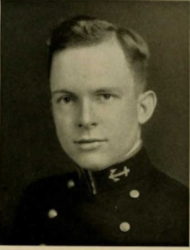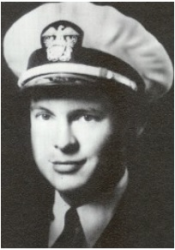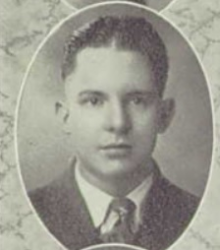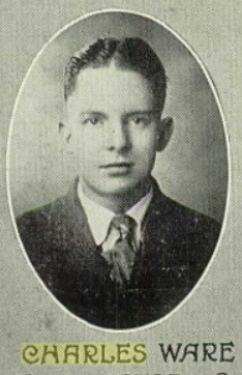
 |
|
|
||
|
CHARLES ROLLINS WARE |
||||
|
Graduate, U.S. Naval Academy, Class of 1934 Engagements: • World War II (1941 - 1945) |
||||
| Biography: | ||||
|
Charles Rollins Ware Lieutenant, United States Navy Navy Cross & Purple Heart Charles Rollins was the son of Walter Levi/Lee Ware and Retta Arvazena “Zena” Hunt who married in Tennessee about 1908. Charles' siblings were Howard Rollins, Willard Lee, and Marie Louise Ware McDonald. Walter and Zena were divorced before 1930. The children stayed with their mother and Walter remarried before 1934. Charles graduated from Knoxville High School in Knoxville, TN on Thursday evening, 31 May 1928, with 423 of his classmates in Jefferson Hall at the University of Tennessee campus. The class was then largest in the history of the high school. In a twist of irony, the general theme of the commencement program was "The World For Peace." One student speaker's topic was "The Menace of War" in which he outlined the horrors and uselessness of war. World War II would cost Charles his life 14 years later almost to the day. Charles was a member of his high school student government in his Junior year. During his senior year, Charles had a leading role in the senior class play, “The Admirable Crichton.” His high school major was science. His classmates said of him, “His only fault is, he has no faults.” He was the Business Manager of the school's Blue and White newspaper; Treasurer Hi-Y Club; and President of Quill and Scroll, the national honorary society for high school journalists. He was also a cadet officer with his award winning high school R.O.T.C. unit. His Senior Class Prophecy said he would become an army colonel. After graduation Charles was employed as an usher at the Tennessee theater in Knoxville. Eighteen years later in 1946, Charles was honored with a wall plaque with 127 other Knoxville High School graduates, who over time, died for “Service and Sacrifice for God and Country.” Ware began his US Navy application for enlistment not long after he graduated from high school. That process included sitting for an aptitude test, physical exam, personal references, police background checks, filling-out various forms and most importantly obtaining his mother's written consent for him to enlist. Charles was accepted for enlistment into the US Navy, and on 13 Jun 1929, with his mother's permission, Charles enlisted in the US Navy from Athens, TN as an Apprentice Seaman (A.S.) for either a 4 or 6 year commitment. Several days later, A.S. Ware arrived at the Naval Training Station (NTS), Great Lakes, IL for 9-weeks of basic training. Toward the end of basic training, A.S. Ware requested an appointment to the US Naval Academy. He sat for a qualifying examination scoring very well, but he did not qualify for direct appointment. However, his scores were high enough that he did qualify for entry into the 6 month Naval Academy Prep School at Hampton Roads, VA. That school would in-effect be his tutor to help him sharpen his academic skills in certain areas like math, science and English. When he finished Prep School in early April 1930, Ware sat for the service-wide competitive Academy entrance exam on 15 April 1930. There were only 100 at-large Naval Academy billets available for fleet personnel. For Charles this was a must-be-selected exam, or he would have to serve out his enlistment in the US Navy fleet in enlisted status. His examination scores qualified AS Ware for one of the 100 US Navy enlisted men at-large appointments to the Naval Academy at Annapolis, MD. Just prior to entering the Naval Academy, A.S. Ware was honorably discharged from enlisted status active duty and the following day he took the oath of office as a Naval Academy Midshipman and accepted the appointment. He entered on 27 Jun 1930 becoming a naval academy midshipman. -------------------- Newspaper articles from Knoxville described a somewhat different scenario regarding Charley's journey to the Naval Academy. Below are details from the articles. Newspaper articles from the Knoxville News-Sentinel (Knoxville, TN) of 13 Jun 1929 indicate that Charles departed today for Great Lakes, IL to begin preliminary training for entrance to the US Naval Academy at Annapolis next June. Following nine weeks at Great Lakes [NTS] and upon showing satisfactory grades in certain examinations, Ware will enter Hampton Roads Naval Preparatory school to finish his pre-Annapolis training. The same newspaper stated on 15 Oct 1929 that Charles R. Ware of Knoxville had passed the examination for admission to the Naval Academy preparatory class at Hampton Roads. Nine days later an article in The Knoxville Journal in Knoxville, TN of 24 Oct 1929 with a byline of Nashville, TN stated that a Lt Eugene B. Oliver, in charge of the local US Army recruiting station, received notification that Charles R. Ware of Knoxville, who recently enlisted at the Nashville station, had passed the preliminary examinations for entrance to the US Naval Academy.---------------------- Midshipman Ware was known by his classmates as “Charlie,” Rollo” or “Chuck.” His classmates said this about him. “He has dragged from fourteen states, two territories, Sweden, Denmark, and Spain. All in all quite a favorite with the ladies. You know some are born with it, others acquire it – reference is suggested to Baltimore. Enough about the femmes. Classical music, and in fact, most any kind appeals to him, although he was one of two men who went their entire Second Class Year with a Vic. Brain power, quoting Charlie, is something to be acquired after long years of arduous struggle. During our sojourn here he has come up from behind more than once." "His early days were spent in sunny Tennessee. Receiving the cosmic urge, or whatever one cares to call it, for higher education he entrenched himself in our stronghold here on the Severn. In dabbling in various fields of endeavor this character has no peer-all the way from firing a rifle to tumbling. Possessing a seemingly natural bent for cheer leading and being an ardent sport enthusiast our All-American cheering section was greatly benefited by his presence in the cheer leader’s boots." "Charlie is an interesting fellow to talk to and quite an asset to any gathering. A good smile coupled with the knack of getting along with people will serve him well in the future. After visiting about half the globe he says it’s a jolly old world after all. We feel that his time here was well spent. On parting we say with all sincerity “adios” . . . until we meet again.” Cheerleader. Rifle Team 2, 1. 2 P.O.Chuck graduated #439/463 in the 1934 class from the Naval Academy on 31 May 1934. He received a Bachelor of Science degree, took the oath of office and accepted a commission as an Ensign of the Line, US Navy. After graduation, he reported to his required sea duty tour on board the battleship, USS Texas (BB-35), on 30 Jun 1934. After several years on board the Texas, Ensign Ware was promoted on 31 May 1937 to Lieutenant Junior Grade (Ltjg). Sometime after 1 July 1938, Ltjg Ware transferred from the USS Texas to the destroyer, USS Dahlgren (DD-187). In late Dec 1939, Ltjg Ware received orders to report for temporary duty under instruction to the Naval Air Station (NAS) Pensacola, FL. He detached from Dahlgren in early Feb 1940 and reported for flight training at the NAS Pensacola, FL., on 26 February 1940. Because of dramatic increases in pilot training requirements mandated by the US government, Ltjg Ware would not start his training until about 15 April, probably with class 138-O (Commissioned Officers selected for aviation training were assigned to separate classes from aviation cadets. Officer classes were designated xxx-O where the x's are single digit numbers, while aviation cadets were in class xxx-C. Cadets had longer training programs than the officers.). In the late summer of 1940, Ltjg Ware completed his primary flight training at NAS Pensacola and was awarded his gold wings and designation as a naval aviator (heavier-than-air). Next, Ware was assigned to advanced tactics training at NAS, Pensacola until late Oct when he detached and transferred to NAS, Miami (Opa-Locka), FL for temporary duty with the Advanced Training Specialized Carrier Group for about four weeks. The training was for officers who were to be carrier-based pilots. While at NAS Miami Ltjg Ware received orders stating that when detached from NAS Miami report to Scouting Squadron 5 (USS Yorktown) for duty involving flying aircraft (heavier-than-air). After a brief visit home on leave, Ltjg Ware reported to Scouting Squadron 5 (VS-5) on 31 Dec 1940. After he reported to VS-5, he was detached for temporary duty with the Advanced Carrier Training Group, Pacific Fleet for 4-6 weeks of advanced flight instruction. He was promoted to Lieutenant (Lt.) on 01 Aug 1941. USS Yorktown steamed out of Pearl Harbor on 20 April 1941 bound via the Panama Canal for Bermuda in the Atlantic and the Neutrality patrol. She arrived on 12 May. On 28 Oct while Yorktown and other American warships were screening a convoy, a US destroyer gained sound contact and attacked with depth charges. Later that night American ships intercepted strong German radio signals indicating probable submarine presence in the vicinity. Two days later while cruiser scout planes patrolled overhead, Yorktown prepared to fuel several destroyers. Other escorts made sound contacts. They attacked. After the attacks, one of the destroyers notice a large, spreading oil slick but no wreckage. That same day, U-552 torpedoed the destroyer USS Reuben James, sending her to the bottom with heavy loss of life. The first loss of an American warship in World War II. After another Neutrality Patrol in November, Yorktown returned to Norfolk, VA where she tied up on 2 Dec 1941. After the outbreak of WWII on 07 Dec 1941, Yorktown departed Norfolk, VA on 16 Dec 1941 and steamed via the Panama Canal for San Diego arriving 30 Dec 1941. She soon became the flagship for RADM Frank Jack Fletcher's newly formed Task Force (TF) 17. Yorktown's first mission was to escort a convoy carrying Marine Corps reinforcements to American Samoa. She was underway on 06 Jan 1942 and with her escorting ships covered the transport of marines to Tutuila and Pago Pago to augment the present garrison. Successfully covering the troop movement, Yorktown, in company with USS Enterprise (CV-6) departed Samoan waters on 25 Jan 1942. Six days later on 01 Feb, TF 8, built around Enterprise, and TF 17, built around Yorktown, parted company. The former headed for the Marshall Islands, the latter for the Gilberts. Each Task Force steamed toward the first American offensive of the war, the Marshall-Gilberts raids. At 0517 on 01 Feb 1942, Yorktown launched 11 torpedo planes (Douglas TBD-1 Devastators) and 17 scout bombers (Douglas SBD-3 Dauntlesses) under the command of Comdr. Curtis W. Smiley. Those planes hit what Japanese shore installations and shipping they could find at Jaluit, Gilbert Islands, but adverse weather conditions hampered the mission. Other Yorktown planes attacked Japanese installations and ships at Makin and Mili Atolls. Ltjg Ware was one of five SBDs led by Lt W.E. Short to attack Mili. He was the pilot of SBD 5-B-11 and his gunner/radioman was Joseph Ellsworth (J.E.) Roll, RM2. When they arrived over Mili there were few targets, there was much cloud cover and they were unopposed. He did attack a bldg but his bomb was a dud. They returned to the Yorktown at 2045. Aircraft losses from Enterprise based Scouting Squadron Six, however, were high during their attacks on the Marshall Islands the same day. In order to quickly replace some of those VS-6 personnel losses, several pilots from Yorktown, including Ltjg Ware, were temporarily assigned to Enterprise's Scouting Six about a week later. The Enterprise and TF 16.8 led by RADM Halsey attacked Wake Island on 24 Feb 1942. Flight quarters was sounded at 0430 and shortly before 0630, the first Combat Air Patrol (CAP) fighters began launching. The strike led by Lcdr Brigham Young as Commander, Enterprise Air Group (CEAG) consisted of Thirty-six SBD 2 and 3 Dauntlesses from VB-6 and VS-6, respectively, and TBD-1 Devastators from VT-6 launched from Enterprise to bomb and strafe ships and installations. Treacherous weather, including frequent squalls and a heavy overcast, hampered the raid and delayed the launch of the strike package. After the CAP launched the 18 SBDs of VS-6 led by Lt Wilmer Earl Gallaher launched next. VS-6 was divided into three divisions of six planes each.There was also one photographic division of VS-6 consisting of three aircraft. Ltjg Ware was assigned to the first division in 6-S-16. His rear seat gunner was ARM2 William Henry Stambaugh. It took an hour from departure from Enterprise for the fifty-one plane strike force led by CEAG to arrive over Wake Island. As the planes approached they could see a rapidly expanding AA barrage more than 20 miles ahead. Shortly after 0750 the scout bombers began their attacks on Wake Island's airfield and other assigned targets. The Scouts completed the dive-bombing phase of the attack at about 0815, and finished glide attacks with light bombs a few minutes later, retiring eastward. By 0945, the strike package began landing on Enterprise. Ltjg Ware returned safely. VS-6 lost two SBDs during the Wake Island raid. Since 07 Dec 1941, VS-6 lost nine pilots and eleven rear seat gunners. Ltjg Ware did not fly into combat again until the Battle of Midway on 4 Jun 1942. On 4 March, Enterprise’s Air Group attacked enemy installations on the Marcus Islands, and on 18 April, she supported the Doolittle raid with CAP over the task group. In early May, Enterprise and the aircraft carrier USS Hornet (CV-8) were dispatched to the South Pacific to assist the aircraft carriers USS Lexington (CV-2) and USS Yorktown (CV-5) who were engaged in the battle of the Coral Sea. However, before the ships arrived on-scene the battle of the Coral Sea was over. After participating in additional operations in the Central Pacific, Enterprise returned to Pearl Harbor on 26 May and began intensive preparations to meet an expected Japanese thrust at Midway Island. Enterprise got underway from Pearl Harbor on 28 May 1942, and with USS Hornet (CV-8), steamed toward a point Northeast of Midway called "Point Luck." USS Yorktown (CV-5) followed a short time later. Early on the morning of 4 Jun 1942, Lt Ware, flying a Douglas Dauntless SBD-2 dive bomber 6-S-4, with other attack aircraft of Air Group Six, as well as planes from Air Groups from Hornet and Yorktown, launched to intercept and attack a large Japanese Carrier force approaching Midway. After VS-6 made a successful attack on the Japanese carrier Kaga, Lt Ware and five other planes from his squadron joined up to return to Enterprise. Enroute home Lt Ware's group was attacked by six Japanese “Zero” fighters that broke away from Japanese carrier Hiryu’s dive-bomber counter strike that was heading toward the carrier USS Yorktown (CV-5). Ware had earlier improvised a tactic of turning into the attacking Japanese Zeros, and did so again, creating an arc with the trailing SBD’s that enabled all rear seat gunners to concentrate their fire on the leading Zeros. Although no American planes were shot down their evasive maneuvers used up precious fuel. After the attack Ware's group split up as they attempted to find the Enterprise. Lt Ware's section, very low on fuel, was never seen again. Lt Ware and his gunner/radioman, ARM1 William H Stambaugh's remains were unrecoverable. He was listed as missing in action on 4 Jun 1942 and presumed dead on 05 Jun 1943. ----------------------------------------------- The President of the United States of America takes pride in presenting the Navy Cross to Charles Rollins Ware, Lieutenant, United States Navy, for extraordinary heroism in operations against the enemy while serving as Pilot of a carrier-based Navy Scouting Plane of Scouting Squadron SIX, attached to the U.S.S. ENTERPRISE, during the "Air Battle of Midway," against enemy Japanese forces on 4 - 6 June 1942. Participating in a devastating assault against a Japanese invasion fleet, Lieutenant Ware, with fortitude and resolute devotion to duty, pressed home his attacks in the face of a formidable barrage of anti-aircraft fire and fierce fighter opposition. His gallant perseverance and disregard for his own personal safety were important contributing factors to the success achieved by our forces and were in keeping with the highest traditions of the United States Naval Service. General Orders: Bureau of Naval Personnel Information Bulletin No. 309 (December 1942) In addition to the Navy Cross which was not awarded posthumously because he hadn't been declared presumed dead yet, Lt Ware was awarded (posthumously) the Purple Heart Medal, Presidential Unit Citation w/ribbon, American Defense Service Medal w/Fleet Clasp, American Campaign Medal with Fleet Clasp, Asiatic-Pacific Campaign Medal and the World War II Victory Medal. --------------------------------------- Enterprise Presidential Unit Citation: For consistently outstanding performance and distinguished achievement during repeated action against enemy Japanese forces in the Pacific war area, 7 December 1941, to 15 November 1942. Participating in nearly every major carrier engagement in the first year of the war, the Enterprise and her air group, exclusive of far-flung destruction of hostile shore installations throughout the battle area, did sink or damage on her own a total of 35 Japanese vessels and shot down a total of 185 Japanese aircraft. Her aggressive spirit and superb combat efficiency are fitting tribute to the officers and men who so gallantly established her as an ahead bulwark in the defense of the American nation. Actions of the Enterprise mentioned in the citation include the Gilbert and Marshalls of 01 Feb 1942; Wake Island raid, 24 Feb 1942; Marcus Island raid, 04 Mar 1942; Battle of Midway, 4-6 Jun 1942; Occupation of Guadalcanal, 7-8 Aug 1942; Battle of Stewart Islands, 24 Aug 1942; Battle of Santa Cruz Islands, 26 Oct 1942; and Battle of Solomon Islands, 14-15 Nov 1942. ---------------------------------------- Task Force 16 Citation Recognizing its contribution to the Doolittle Raid, 18 April 1942 On the occasion of the 50th anniversary of the Second World War, it is appropriate that we take time to reflect on the unique and daring accomplishments achieved early in the war by Task Force 16. Sailing westward under sealed orders in April 1942, only four months after the devastating raid on Pearl Harbor, Task Force 16, carrying sixteen Army B-25 bombers, proceeded into history. Facing adverse weather and under constant threat of discovery before bombers could be launched to strike the Japanese homeland, the crews of the ships and LTC Doolittle's bombers persevered. On 18 April 1942 at 14:45, perseverance produced success as radio broadcasts from Japan confirmed the success of the raids. These raids were an enormous boost to the morale of the American people in those early and dark days of the war and a harbinger of the future for the Japanese High Command that had so foolishly awakened "The Sleeping Giant." These exploits, which so inspired the service men and women and the nation live on today and are remembered when the necessity of success against all odds is required. (Signed) John H.Dalton Secretary of the Navy 15 May 1995 --------------------------------------- USS Charles R. Ware (DE-547) was canceled prior to construction. In Lt. Ware's honor, the USS Charles R Ware (DD-865), a Gearing class destroyer, was launched at Bethlehem Steel Shipyard, Staten Island, NY, April 12, 1945, by Arva Zena Ware, his mother, and was commissioned on 21 July 1945. For the next 29 years, DD-865 served the U.S. Navy well around the world, including in the waters off Vietnam in 1967. After serving for a time as a Naval Reserve training ship, the Ware was decommissioned November 30, 1974 in Galveston, TX. On November 15, 1981, the ship was used as a target and was sunk in 3000 fathoms in the Atlantic Ocean, 400 miles northeast of Puerto Rico. ---------------------------------- His family also received a commemoration from President Franklin D. Roosevelt. It reads: In grateful memory of Charles Rollins Ware, who died in the service of his country, SEA, Pacific Area, ATTACHED U.S.S. ENTERPRISE, 5 JUNE 1943 (Presumed). He stands in the unbroken line of patriots who have dared to die that freedom might live and grow and increase its blessings. Freedom lives, and through it, he lives -- in a way that humbles the undertakings of most men. (Signed) Franklin D. Roosevelt, President of the United States -------------------------------- Combat Action Ribbon (CR) note: None of the Navy/Marine flight crews in the Battle of Midway were eligible for or were awarded the Combat Action Ribbon (CR). See Navy and Marine Corps Awards Manual (SECNAVINST M-1650.1 of 16 Aug 2019, Appendix 2C.1.c (3) Amplifying Guidance). It reads in part, “The CR will not be awarded in connection with aerial flight, . . . “ The CR was established in 1969 and made retroactive to 07 Dec 1941. According to the Awards Manual, when deemed appropriate, the award for aerial combat is the Air Medal. -------------------------------------- [Bio #199 compiled by GML470] Find A Grave Memorial Page#232114099 |
||||
| Honoree ID: 104020 | Created by: MHOH | |||
Ribbons
Medals
Badges
Honoree Photos
 |  |  |
 |  |
 |


